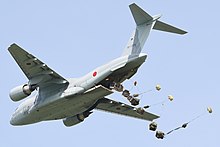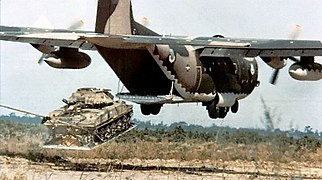
A military aircraft is any fixed-wing or rotary-wing aircraft that is operated by a legal or insurrectionary military of any type. Military aircraft can be either combat or non-combat:

Airborne forces are ground combat units carried by aircraft and airdropped into battle zones, typically by parachute drop. Parachute-qualified infantry and support personnel serving in airborne units are also known as paratroopers.

High-altitude military parachuting, or military free fall (MFF), is a method of delivering military personnel, military equipment, and other military supplies from a transport aircraft at a high altitude via free-fall parachute insertion. Two techniques are used: HALO and HAHO.

Aerial warfare is the use of military aircraft and other flying machines in warfare. Aerial warfare includes bombers attacking enemy installations or a concentration of enemy troops or strategic targets; fighter aircraft battling for control of airspace; attack aircraft engaging in close air support against ground targets; naval aviation flying against sea and nearby land targets; gliders, helicopters and other aircraft to carry airborne forces such as paratroopers; aerial refueling tankers to extend operation time or range; and military transport aircraft to move cargo and personnel.

A loadmaster is an aircrew member on civilian aircraft or military transport aircraft tasked with the safe loading, transport and unloading of aerial cargoes. Loadmasters serve in the militaries and civilian airlines of many nations.
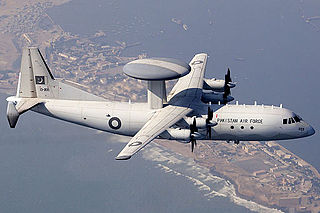
The Shaanxi Y-8 or Yunshuji-8 aircraft is a medium size medium range transport aircraft produced by Shaanxi Aircraft Corporation in China, based on the Soviet Antonov An-12. It has become one of China's most popular military and civilian transport/cargo aircraft, with many variants produced and exported. Although the An-12 is no longer made in Ukraine, the Chinese Y-8 continues to be upgraded and produced. An estimated 169 Y-8 aircraft had been built by 2010.
A parachute rigger is a person who is trained or licensed to pack, maintain or repair parachutes. A rigger is required to understand fabrics, hardware, webbing, regulations, sewing, packing, and other aspects related to the building, packing, repair, and maintenance of parachutes.

Military gliders have been used by the militaries of various countries for carrying troops and heavy equipment to a combat zone, mainly during the Second World War. These engineless aircraft were towed into the air and most of the way to their target by military transport planes, e.g., C-47 Skytrain or Dakota, or bombers relegated to secondary activities, e.g., Short Stirling. Most military gliders do not soar, although there were attempts to build military sailplanes as well, such as the DFS 228.

The low-altitude parachute-extraction system (LAPES) / Low-level parachute extraction resupply system (LOLEX) is a tactical military airlift delivery method where a fixed-wing cargo aircraft can deposit supplies in situations in which landing is not an option, in an area that is too small to accurately parachute supplies from a high altitude. This practice is no longer used in the USAF.
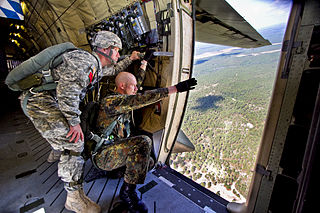
Jumpmasters are the expert paratroopers in an airborne unit who train and teach the military techniques for jumping from airplanes. They are responsible for training soldiers who enter Army Airborne School into paratroopers and managing airborne jump operations in airborne units across all branches of services.
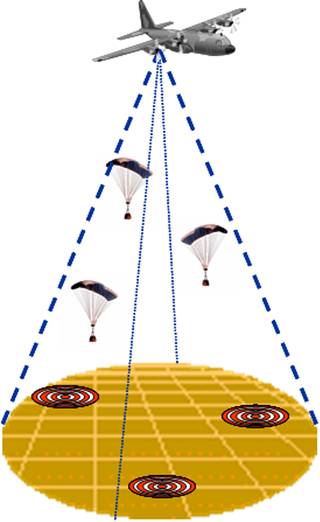
The Joint Precision Airdrop System (JPADS) is an American military airdrop system which uses the Global Positioning System (GPS), steerable parachutes, and an onboard computer to steer loads to a designated point of impact (PI) on a drop zone (DZ). The JPADS family of systems consists of several precision airdrop systems, ranging from extra light to heavy payloads. JPADS is used in conjunction with mission planning software that resides on a laptop. The function of this mission planning software includes computing release points, weather forecasting, acquiring measurements of wind velocity, altitude, air pressure, and temperature. It can also receive weather updates and en route mission changes through satellite links.

No 620 Squadron was a squadron of the Royal Air Force during World War II. During its existence it served as a bomber squadron, airborne forces and a transport squadron.

Aerial Port Squadron (APS) is a United States Air Force organization which operates and provides the military logistical functions assigned to aerial ports, including processing personnel and cargo, rigging for airdrop, packing parachutes, loading equipment, preparing air cargo and load plans, loading and securing aircraft, ejecting cargo for inflight delivery, and supervising units engaged in aircraft loading and unloading operations.

The Joint Air Delivery Test and Evaluation Unit (JADTEU) is a tri-service unit is an Air Warfare Centre unit located at RAF Brize Norton, England. Commanded by a lieutenant colonel, it has a combined strength of approximately 115 military personnel and civil servants. Its primary role is to conduct operational trials and evaluation and to develop the delivery by air of personnel, machines and materiel on behalf of sponsors. In addition it provides advice/recommendations to MOD sponsors, other government departments, civilian industry and foreign governments on all air transport matters. It received ISO 9001 accreditation in 1997, this a requirement of holding Design Approved Organisation Scheme (DAOS) approval.

The 355th Tactical Airlift Squadron is an inactive United States Air Force unit. Its last assignment was with 906th Tactical Airlift Group stationed at Rickenbacker Air National Guard Base, Ohio. It was inactivated on 1 July 1982.
Exercise SWARMER was a large-scale military exercise conducted in the spring of 1950 by the United States Air Force, United States Army, and United States Navy in the area of Fort Bragg, North Carolina in the southeastern United States. SWARMER was designed to test the capability of the Air Force and Army to operate and maintain an airhead, a base secured in enemy territory where troops and supplies could be received and evacuated by air, under simulated combat conditions. This was also the first tactical use of the strategic airlift technique, intending to apply lessons learned during the Berlin Airlift to battlefield logistics.
No. 6 Squadron, nicknamed the Antelopes, is a transport squadron of the Pakistan Air Force. It is the PAF's oldest squadron which is currently based at Nur Khan Air Base and operates the C-130 & CN-235 transport aircraft.

Ground Parachute Extraction System (GPES) refers to a method by which ground forces are resupplied by low altitude air drops. It has also been referred to as Ground Proximity Extraction System. The system, developed jointly by the United States Air Force and Army, is similar to the arrester technique used on aircraft carriers. The cargo aircraft flies low over the delivery area. A hook is attached to the pallet load. Another hook at the other end of the cable line is attached to the rear cargo door. When the plane nears the delivery site, the hook at the cargo door snags an arrester wire that is placed perpendicular to the plane's flight path thereby yanking the pallet load out of the aircraft to the intended delivery site.
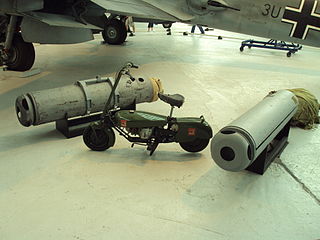
The CLE Canister, or CLE Container was a standardized cylindrical container used by the British during World War II to airdrop supplies to troops on the ground. The name initially derived from the Central Landing Establishment that developed them, although this was later backronymed to Container Light Equipment.

Rapid Dragon is a palletized and disposable weapons module which is airdropped in order to deploy flying munitions, typically cruise missiles, from unmodified cargo planes. Developed by the United States Air Force and Lockheed, the airdrop-rigged pallets, called "deployment boxes," provide a low cost method allowing unmodified cargo planes, such as C-130 or C-17 aircraft, to be temporarily repurposed as standoff bombers capable of mass launching any variant of long or short range AGM-158 JASSM cruise missiles against land or naval targets.
